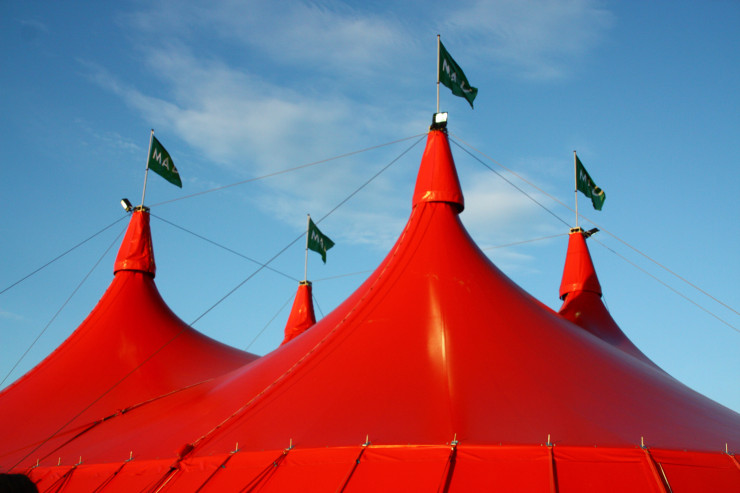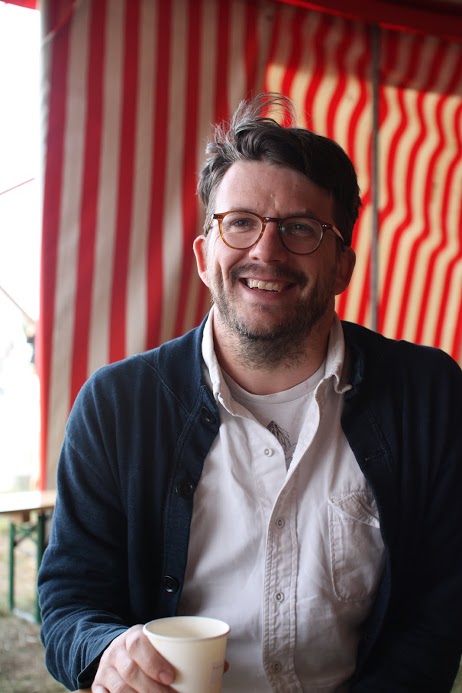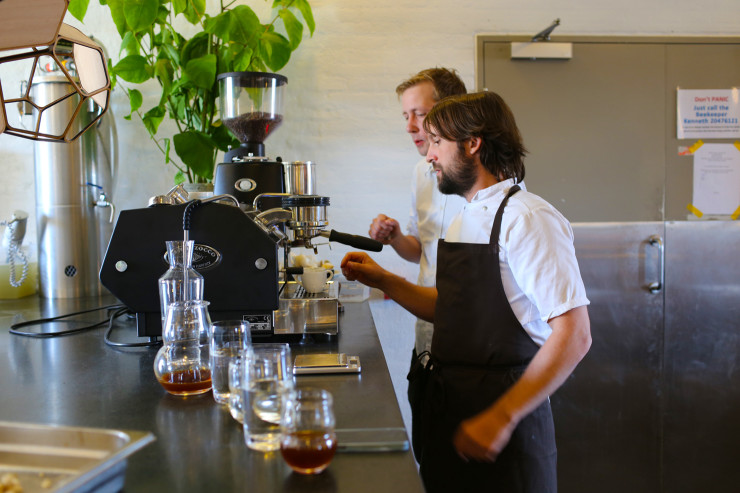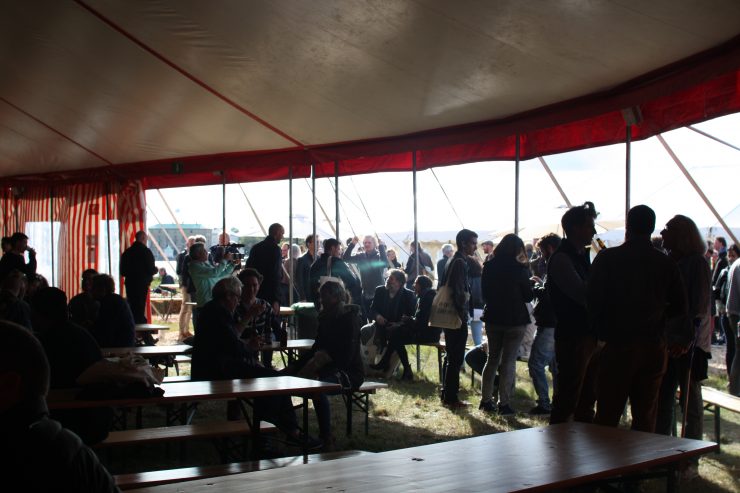Peter Meehan, journalist and co-creator of the beautiful food journal Lucky Peach, helped curate MAD Symposium last year. He also worked with MAD on the organization’s first NYC date for their MAD Monday discussion series. During his time writing for the New York Times, Meehan was one of the true trailblazers in writing seriously about coffee: he covered the third wave of coffee’s initial laps to shore 8 years ago, he followed stories such as then-upstart roasteries’ journeys towards a superior product, and he experienced the fatigue of an at times self-serious young industry trying to figure out how to reach its customers.
I was in attendance at this year’s MAD Symposium, primarily to survey the coffee scene and talk with chefs about their experiences with coffee. I hadn’t anticipated interviewing Meehan, but after an introduction we commenced a conversation on what he sees happening within the coffee industry, sprouting from his take as editor of Lucky Peach. Hearing his perspective as someone who observes food and beverage industries with passion, but something of a remove, was refreshing.
I guess for those in the coffee industry who devour the pages of Lucky Peach in earnest, it would raise a cheer if a coffee element was featured. Would it ever happen?
In terms of why haven’t we? You know, I’m interested in everything but I feel like we haven’t done much wine, beer or coffee coverage…for me, stories in Lucky Peach have to be stories first and foremost, so a polemic about something or an update on the state of change in industry is less interesting than a narrative. Just giving the example of beer, we haven’t done many beer stories but beer is a wonderful thing. There was a story in the New York Times about Mikkeller and his brother at Evil Twin and I thought ‘Oh, that’s a great story about people because there’s a dynamic.’ You can talk not only but what’s happening in a brewery but you can also wrap it into a narrative.
Coffee is a young industry, and moreover, writing about coffee is an extremely young industry. Do you think it’s engaging enough for people?
Yeah, storytelling is the way that you make things compelling, but I get pitched very few coffee stories and I’ve been pitched no coffee stories that tell the story of people doing something. I think that the stories that would probably be interesting would be about the things happening in Central America or Eastern Africa or something, and those are hard stories to report. Those are hard stories to go down and get and be involved in for privileged people.
René [Redzepi] was advocating for coffee coverage in the Lucky Peach supplement we did about MAD last year because we did have that coffee book. But for me, I guess it wasn’t telling a story, a new story. And that’s it, what we are first and foremost are is we’re quarterly—we’re not timely—and we’re not really on trend and we tell stories about a theme. We have an upcoming theme about obsession, obsession could be… we could tell a story about George Howell and Cup of Excellence and how he developed that and what he did there and that’s a crazy obsession guy who’s done a lot right there.
Is it too nerdy?
I do not fear nerddom at all. We don’t fear length and complexity and I don’t worry about things being unappealing to people, because if we believe in the story we’re gonna tell the story, whatever the subject.
But I don’t feel like coffee’s being kept out in the States at all… the coffee culture in New York versus when I first started giving a shit and interacting with it in 2003/2004, to now, is insane. It is easy to get a great cup of coffee, a conscientiously pulled espresso and a well-built drink, almost anywhere in New York.
How about in restaurants?
I’ve got nothing on that… it’s perplexing to me. I think it’s really interesting what René has done, serving that super-premium Esmeralda and super-duper nerd light roast that makes it taste like tea and you know, that’s a very aggressive but amazing coffee program put together there. I don’t know why other restaurants aren’t following suit.
Do you want them to? Does it matter?
Well yeah, for the very obvious reason that they wouldn’t serve shitty wine, they wouldn’t serve shitty bread, or they wouldn’t use shitty vegetables. Why do you serve shitty coffee?
As a consumer, do you care that you’ll have a meal and finish it with something bitter or prefer nothing at all? Would you choose to have something delicate or would you do bitter, fullstop?
No, I don’t like the bitter fullstop, but I do like…well, the Nordic light roast—I’ve spent a lot of time with it, I’ve drunk a lot of it and I’ve cupped it. I understand its appeal and its benefit in terms of bringing out like honeysuckle flavours and things like that, but I like a medium roast—not dark roast, not like Starbucks shiny bean action. But I think that a lot of chefs I know drink good coffee when they go to espresso places. I don’t know why it hasn’t made the leap over. I feel like… are you familiar with the show The Wire? I feel like there’s an element of y’know, “Follow the money”, and where do you get a La Marzocco, how much does that cost? And the service agreement that goes with that. But I think that roasters are making inroads and it’s really on them to educate, to beat the street at great restaurants. How do wine companies get their wine into restaurants? They show up and sell, and that’s really where it’s at. I think with the change that they’ve made in cafe culture, there’s already an appetite for it. I don’t think it’s really a long time until restaurants start serving better coffee. At least, I think a lot of restaurants, or rather a certain class of restaurant will serve better coffee.
How do you think it can operate, placing high quality coffee on menus?
I think tasting is believing and that’s the thing of it, but it requires manpower and it requires the same thing for them to get into cafes, it requires the same thing for roasteries to convert people to caring about or having the conception that there’s a difference between one type of coffee and another. And ultimately they stand to profit.
I think that when I first started covering coffee, I believed in direct trade as having a form of social justice to it. I believed in a lot of the good that can come from good coffee. The thing that I’ve seen, watching the industry growing up at least in in America is there’s an enormous amount of the money that’s being paid for those bags of beans going into building brands—and I’m pro-capitalism, but how much did Blue Bottle sell for? How much did Stumptown go for? And I love Stumptown, I buy Stumptown all the time. Those were companies that were built for profit and then sold for a shitload of money, so I don’t buy that it’s somebody’s fault that more people aren’t using their product. I think it’s on them—it’s on them to create more opportunities—it’s on them as business and hopefully through continual good practice they’ll keep benefiting farmers and then the money that goes to origin, hopefully it continues to reform agricultural coffee farms.
For roasters, where is the best place to start when approaching restaurants?
How much are people responding to their customer if there is an ideological commitment to a super light roast, because it preserves characteristics in the coffee that are prized by the geekiest among us, but it alienates a consumer that wants something that tastes like coffee? Which can still be delicious, but is probably a little bit further down the shade…probably Central America and not in a Nordic roast. Probably medium roast. Are you going to meet people there, are you gonna work with them to create a product that works for everyone, or is it an imposition of an ideal that must be adapted? Because I think that’s a harder thing.
How much do you think consumer tastes and behaviours will change?
You can revise a way… I grew up drinking Dunkin’ Donuts coffee and, y’know, coffee out of a can, and I came around to coffee, but there’s that old saying: ‘You can lead a horse to water but you can’t make him drink.’ I think the question is, are the roasters doing enough to bring the horse to water?
Be open and share. Look at the way coffee grew in the second wave phase, when Starbucks and cafes were becoming third places for people to be outside of their homes, and it was inclusive and a way to get people to drink. I think that new roasters need to find their stride like that, where it’s bringing people in and it’s not telling them that their taste is wrong if their taste isn’t the same. I think there’s an enormous education opportunity there.
What about the future of coffee? Specialty is still such a young subset of the industry.
I don’t work in that in that world but I look at it critically. I can watch the roasters and watch the cafes. I think coffee is so much bigger now than it was ten years ago; people are so much more aware of it. We know what a good cup is now, or at least have an idea of what a good cup is—or even just knowing that there is a good cup of it. It can’t just be like a shaming fight.
Nico Halliday is a Sprudge.com contributor based in London. Read more Nico Halliday on Sprudge.





